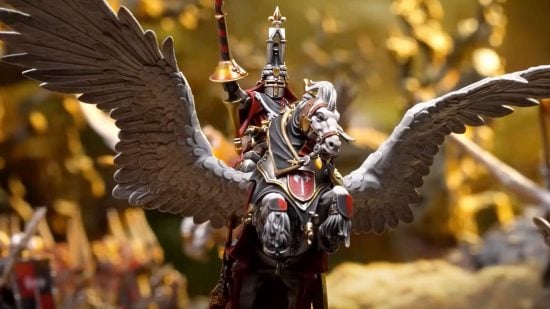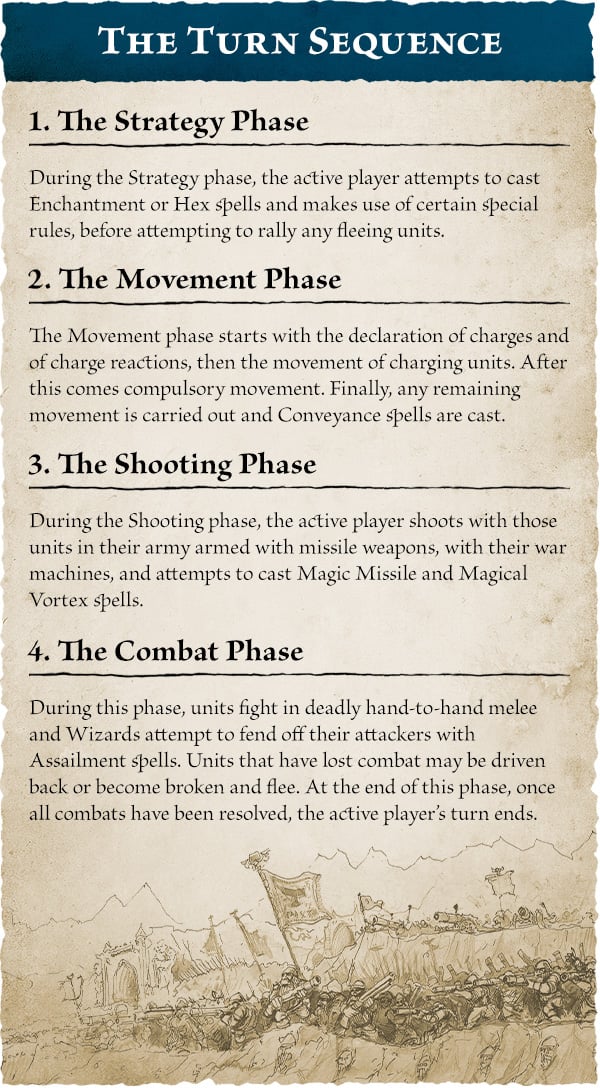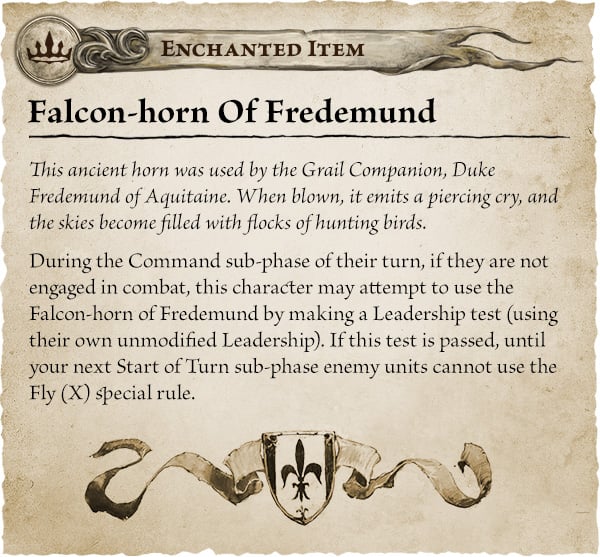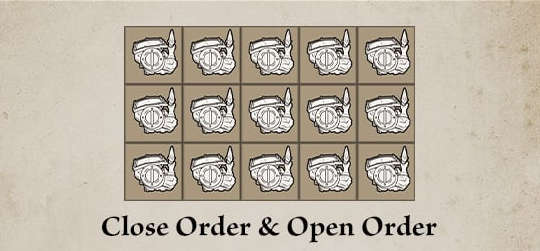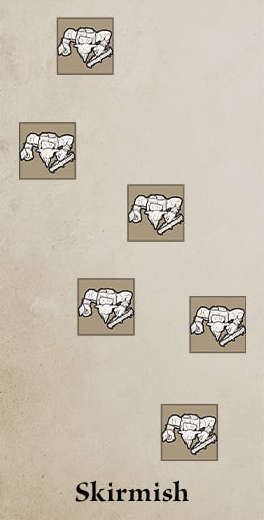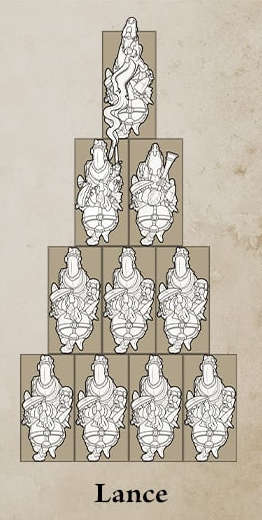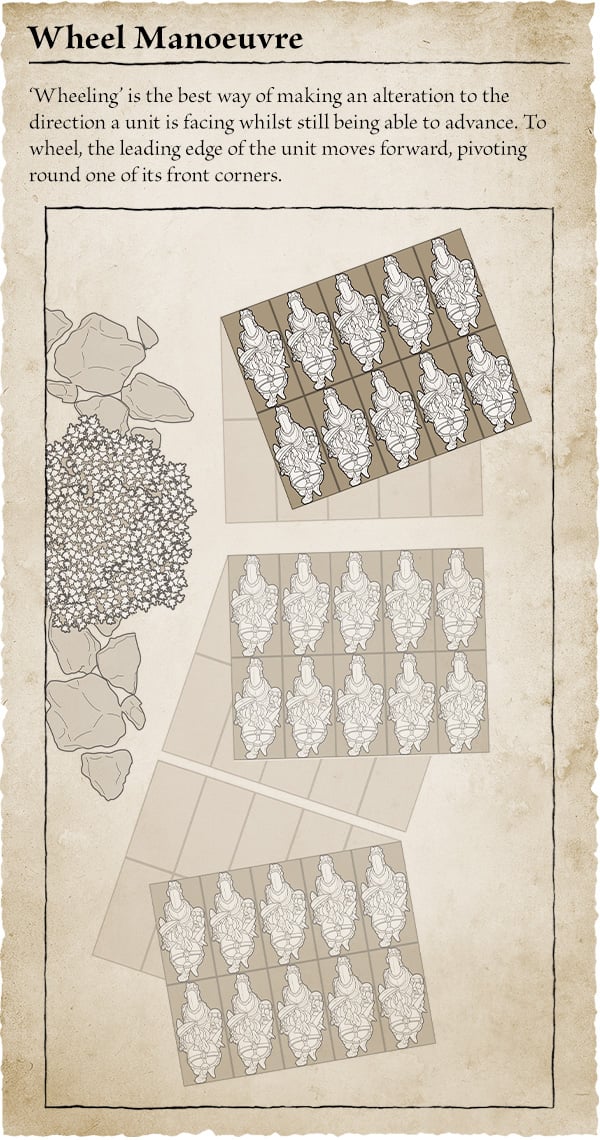Games Workshop has started to preview the Warhammer The Old World rules, ahead of the game’s launch early in 2024. Articles posted on the Warhammer Community website have so far examined the game’s new Strategy Phase, as well as the familiar Movement phase.
We still don’t know the Warhammer: The Old World release date, though Games Workshop has confirmed it will be one of the first releases in 2024. GW gave some top-level information about Warhammer The Old World rules in a development diary in July 2023, but this new article series is going into substantial detail for the first time.
Here’s what we know about the Warhammer the Old World rules so far:
- Warhammer: The Old World Turn Sequence
- Warhammer: The Old World Strategy Phase
- Warhammer: The Old World Movement Phase
- Warhammer: The Old World formations
- Warhammer: The Old World manoeuvres
- Warhammer: The Old World Shooting Phase
- Warhammer: The Old World Combat Phase
- Warhammer: The Old World magic
- Warhammer: The Old World psychology
- Warhammer: The Old World Universal Special Rules
Warhammer: the Old World Turn Sequence
Games of Warhammer: The Old World will be split into several rounds, with each player taking one turn during a round. A player’s turn is “broken down into four main phases: the Strategy Phase, the Movement Phase, the Shooting Phase, and the Combat Phase”, and “each Phase is broken down into four steps called Sub-phases”.
| Phase | What happens |
| Strategy Phase | Units use special abilities and makes special tests; wizards attempt to conjure enchantments and hexes; attempt to rally fleeing units. |
| Movement Phase | Declare charges and reactions, move charging units, compulsory movement, remaining moves and Conveyance spells |
| Shooting Phase | Shoot with missile weapons, war machines, and Wizards attempt to cast Magic Missile and Magical Vortex spells |
| Combat Phase | Units fight, Wizards attempt to use Assailment spells; units that lose combat may be driven back, or become broken and flee. |
Warhammer The Old World: Strategy Phase
The Strategy Phase is a new addition to Warhammer: The Old World. It’s broken into four sub-phases; Start of Turn, Command, Conjuration, and Rally Fleeing Troops. Here’s what happens in each sub-phase:
| Strategy Sub-Phase | What happens |
| Start of Turn | Unit-specific special actions and tests; check victory conditions of the scenario |
| Command | Heroes use special abilities |
| Conjuration | Wizards who aren’t fleeing can attempt to cast Enchantments (buff spells) or Hexes (debuff spells) |
| Rally Fleeing Troops | Make Rally tests for all your Fleeing units. |
The article from October 30 explains that the ‘Start of Turn’ sub-phase is used to resolve things like Stupidity tests for Stone trolls, or the ability of Night Goblin Fanatics to pop out of units of other goblins.
The preview also gives an example of a Character’s special rule. The Falcon-horn of Fredemund allows a Bretonnian Lord to take a leadership test, and strip enemy units of the ability to fly until the Bretonnian’s next Start of Turn phase if they succeed.
Warhammer the Old World Movement Phase
The Movement Phase is broken into four sub-phases; Declare Charges, Charge Moves, Compulsory Moves, and Remaining Moves. Here’s what happens in each sub-phase:
| Movement Sub-phase | What happens |
| Declare Charges | Active player picks charge targets for each eligible unit; inactive player declares charge reactions. |
| Charge Moves | Active player rolls to determine the charge distance of each of their units, then attempts to move the unit into base contact with its target. |
| Compulsory Moves | Fleeing units, and units with rare rules (like Night Goblins Random Movement, or Stone Trolls affected by Stupidity) |
| Remaining Moves | Any units that haven’t moved yet can do so, but may not contact enemy units. |
A unit can declare a charge provided it isn’t fleeing, hasn’t rallied this turn, and isn’t engaged in combat. Charges can only be declared against targets visible to the unit, and at least partially in its front arc. You’re allowed to pre-measure distances to check if this is possible.
Units being charged can make several charge reactions. It’s possible to Hold and receive the charge, turn 180° and Flee, or Stand and Shoot at an enemy that is further away than that enemy’s Movement characteristic. WarCom says that some units may be able to Counter Charge, but hasn’t specified how this works.
Units charge a distance equal to their Movement characteristic, plus the better result from rolling two D6. Games Workshop states that the Swifstride special rule will grant a unit an extra D6″ movement when charging. The unit must move the full distance of its charge roll towards the charge target, even if that doesn’t bring it into base to base contact!
Warhammer the Old World Formations
Every Unit adopts a specific Formation when fighting on the battlefield. Some of these will be restricted to specific units: for example, only Bretonnian Knights can adopt a Lance Formation. Here are the formations revealed so far:
Close Order
Models in a Close Order unit must be ‘ranked up’, so that the models are base to base with each other and form a rectangular block. The unit must be at least as wide as it is deep when it deploys to the battlefield. The unit will hold this formation while it moves, and must perform wheel and turn maneuvers to navigate around obstacles.
While the unit is wider than it is deep it is said to be in Combat Order, allowing it to claim a ‘greater advantage in combat’ the more ranks it has. In previous editions of Warhammer this equated to a +1 bonus to combat resolution per ‘complete’ rank of either four or five warriors (depending on edition).
To move more rapidly, the unit can switch to Marching Order. It loses any rank bonus in combat, but can move at triple speed.
Open Order
Open Order units also fight in ranks, but they’re ‘faster, more agile, and handle tough terrain better’, according to the WarCom article from November 6.
Skirmish
Skirmish units don’t need to form ranks. Instead, each model must remain with 1″ of another model in the unit. In previous editions of Warhammer, Skirmishing units have tended to form up into ranks when they engage in combat with another unit.
Lance
The Lance is only available to Bretonnian cavalry, and so far Games Workshop hasn’t specified how it works. A diagram shows it to be a triangular formation, with one knight in the first rank, two in the second, three in the third, and so on. In previous editions of Warhammer, every model on the outside of a Lance was treated as being in the front rank and thus able to fight in combat.
Warhammer the Old World manoeuvres
The models in Close Order, Open Order and Lance Formation units must stick together when moving around the battlefield. Rules for manoeuvres are a key part of the game, as huge blocks of infantry and cavalry attempt to keep their battleline intact while moving around terrain features.
Units can either Move at their normal speed, or sacrifice maneuvrability and the ability to shoot in order to March more rapidly.
| Type of move | Speed (inches) | Limitations |
| Move | Move stat | None |
| March | 2x Move stat (3x Move stat if in Marching Order) | May not shoot; Wheel manoeuvres only |
In order for the huge units to effectively reposition around the battlefield, they need to use various manoeuvres. Games Workshop revealed how some of these function in a WarCom article on November 6.
| Manoeuvre | Effect |
| Wheel | Pivot the unit around either its left or right front corner. This unit is considered to have moved as much as the leading corner moved forward. |
| Turn | Turn each model in the unit by 90° or 180°, costing 1/4 of its movement per 90°. |
| Move Backwards | Move at half speed; may not march |
| Move Sideways | Move at half speed; may not march |
| Redress the Ranks | Not yet explained – in past editions, this tidied up units after combat |
| Reform | Not yet explained – in past editions, this allowed the unit to change the width and depth of its formation |
Warhammer the Old World shooting phase
During the shooting phase, each of your units that is able to shoot will proceed through these four steps: Declare Targets, Roll to Hit, Roll to Wound, and Remove Casualties. Games Workshop describes the phase in a WarCom article on November 13.
Units can shoot if they meet these conditions:
- Unit has a ranged weapon.
- Unit has not marched or charged.
- Unit is not fleeing.
- Unit is not in combat.
Declare Targets
In the Declare Targets step, you’ll pick one (and only one) Target for the Unit. Models within the Unit may shoot at the Target if they have line of sight to it, and either:
- The model is in the front rank of their Unit
- Their Unit is on a hill
- The model has the Volley Fire special rule.
Models will ordinarily fire one shot each unless they have a special rule
Roll to Hit in the Shooting Phase
You will roll To Hit for each shooting model, rolling one D6 per model and looking for high rolls. The number you need to succeed depends on the models’ Ballistic Skill, and any modifiers which may increase or decrease the result of the roll.
| Ballistic skill | Target number |
| 1 | 6+ |
| 2 | 5+ |
| 3 | 4+ |
| 4 | 3+ |
| 5 | 2+ |
Results of one always miss. Some models may have exceptionally high Ballistic Skills, in which case they can reroll result of one, but need a higher result to hit on this reroll. If a model ever needs a result of 7+ to hit, they need to score a six and then succeed on a second die roll.
| Ballistic skill and modifiers | Target number |
| -2 | 9+ (6+ followed by 6+) |
| -1 | 8+ (6+ followed by 5+) |
| 0 | 7+ (6+ followed by 4+) |
| 1 | 6+ |
| 2 | 5+ |
| 3 | 4+ |
| 4 | 3+ |
| 5 | 2+ |
| 6 | 2 (reroll ones, hitting on 6+) |
| 7 | 2 (reroll ones, hitting on 5+) |
| 8 | 2 (reroll ones, hitting on 4+) |
| 9 | 2 (reroll ones, hitting on 3+) |
| 10 | 2 (reroll ones, hitting on 2+) |
Games Workshop has so far revealed that there’s a -1 to hit penalty for shooting attacks for each of these conditions:
- Shooting model moved
- Target is at long range
- Shooting model is receiving a charge
- Target has partial cover
In previous editions, there were also +1 to hit modifiers when targeting Large models, and -1 to hit modifiers when making multiple shots with rapid-firing weapons: there may be others.
Roll to Wound in the Shooting Phase
For each hit scored on a target unit, the attacker will roll one die To Wound. A WarCom article from November 13 reveals the To Wound chart for the game. The higher the attacker’s Strength is compared to the Target’s toughness, the easier it will be to wound them.
| Target’s Toughness is | Target number |
| Two or more points lower than the attacker’s Strength | 2+ |
| One point lower than the attacker’s Strength | 3+ |
| The same as the attacker’s Strength | 4+ |
| One point higher than the attacker’s Strength | 5+ |
| Two to five points higher than the attacker’s Strength | 6+ |
| Six or more points higher than the attacker’s Strength | Cannot be wounded |
Saving throws
Models can attempt to pass saving throws to avoid wounds. The November 13 preview gives some basic information about the kinds of save bonus different armor provides: we’ve filled in some gaps with information from previous editions. The actual number you will need to roll will be modified by the Armor Penetration of the attacking weapon.
| Type of armor | Saving throw |
| Light armor | 6+ |
| Heavy armor | 5+ |
| Shield | Improved (+1 in previous editions) |
| Barded Mount | Improved (+2 in previous editions) |
| Spells | Improved, depends on spell |
| Magical items | Improved, depends on item |
In addition to saves from armor, models may be able to make Ward Saves which are “made after the armor roll has failed” and “cannot be modified by AP”, according to Warhammer Community.
Remove casualties
Any Wounds that are unsaved will be allocated to models in the unit, killing them when they’ve suffered as many Wounds as their Wound stat. If the unit suffers one quarter or more of its models in casualties from shooting, the survivors will need to make a “panic test” – Games Workshop states it will get to that in another article.
In previous editions, Panic tests were made by rolling two dice and attempting to score equal to or under a unit’s leadership value. If unsuccessful, the unit would break and flee, potentially inducing Panic in other units in the army.
Warhammer the Old World Combat Phase
The core of the Combat Phase for the Old World is very similar to previous editions of Warhammer Fantasy battle: the models in opposing units make attacks against one another, with the number of unsaved wounds they inflict a key factor to determine the result of the combat. The loser of combat then faces a break test, and risks fleeing and being swept off the table.
We’ve put together a separate Warhammer: The Old World Combat Phase guide that goes into greater detail on this critical aspect of the game.
Warhammer the Old World magic
In Warhammer the Old World, magic isn’t resolved in its own phase like it was in earlier editions of Warhammer. Instead, wizards are able to use their magical abilities at different points throughout the turn sequence, depending on what kind of magic they are using:
| Phase | Spells |
| Strategy Phase | Hexes and Enchantments |
| Movement Phase | Conveyance |
| Shooting Phase | Magic Missile and Magical Vortex |
| Combat Phase | Assailment |
Wizards know a number of spells equal to their Wizard level. To cast a spell, they roll 2D6, add their Wizard level, and attempt to score equal to or greater than the spell’s casting value. Opposing Wizards can attempt to dispel the magic by making their own 2D6 roll, adding their Wizard level.
Warhammer the Old World psychology
Games Workshop’s preview from November 27 explains the basics of unit Psychology and morale; these are game effects that are tied to a unit’s Leadership statistic. Leadership tests and Break tests are made by rolling 2D6 and comparing the result to the unit’s Leadership value.
Break tests
When a unit loses combat, it must make a Break test, rolling 2D6 and comparing the result both to their Leadership value, and to their Leadership value modified by amount by which they lost combat. Depending on how they roll they may give ground, fall back but rapidly rally, or turn tail and flee.
You can find more details of these rules in our article on the Warhammer Old World combat phase.

Panic tests
When a unit suffers 25% or more casualties in a phase other than the Combat phase, when a nearby unit with unit strength 5 or more breaks from combat, or a nearby unit is destroyed, units within 6″ must make a Panic test. They must roll 2D6 and attempt to score equal to or under their Leadership score.
If they fail, they’ll turn tail. If the unit has at least half its original models remaining, it will Fall Back in Good Order, rolling 2D6, discarding the lower result, and moving backwards that many inches before rallying. If it has fewer, it will flee 2D6″ and remain fleeing.
Rally tests
Fleeing units take a Rally test at the end of their controller’s Strategy phase, rolling 2D6 and comparing it with their Leadership value. If they roll equal to or under they pass the test, and get to make a free Reform move. Failure will see them make a compulsory 2D6″ flee move during the Movement phase.
Heavily damaged units will find it harder to Rally, with a -1 modifier to their Leadership if below half strength, and -if below 25% of their starting strength, need to roll a natural double one to pass their Rally check.
A unit cannot charge in the turn it rallies, and counts as having moved even if it remains still for the purposes of shooting ranged weapons.
Psychology
In previous editions, Psychology had its own section in the rulebook but the various Psychology related abilities – like Frenzy, or Stupidity – are now treated as Universal Special Rules (ie, special rules that models from any army may have).
Warhammer the Old World Universal Special Rules
The WarCom articles have revealed several special rules for units and weapons, though not all of them have been explained. We’ve summarised them here, either with the information that has been revealed so far, or their performance in previous editions of Warhammer.
| Special rule | Effect |
| Animosity | In previous editions, Animosity was a special rule specific to Orcs and Goblins, which caused units within the same army to misbehave and behave randomly as they started bickering. |
| Armour Bane (n) | In 8th edition, ‘Armour Piercing’ attacks inflicted an additional penalty to armor saves. |
| Breath Weapons | In 8th edition, models with Breath Weapons could use them once per game to make a special shooting attack or melee attack. The ranged attack uses a teardrop template to determine models hit, rather than rolling to hit, while the melee attack inflicted 2D6 automatic hits. |
| Bombardment | The preview from November 13 attaches this to the Screaming Skull Catapult, which fires a 3″ blast template in a parabolic arc; it’s likely a rule related to indirect fire weaponry, or to siege weaponry. |
| Cumbersome | In 8th edition, ‘Slow to Fire’ weapons could not be used to make Stand and Shoot reactions. |
| Fear | “If an enemy with lower Unit Strength wishes to charge a Fear-causing unit, it must first take a Leadership test, or its charge will fail.” If it’s already engaged with a Fear-causing foe, it must pass a leadership test or suffer -1 to hit. |
| Fire & flee | In 8th edition this granted a unit an additional charge reaction, allowing them to shoot and then voluntarily flee when charged. |
| Flaming Attacks | In 8th edition, Flaming Attacks had special properties against certain types of enemies. War beasts, cavalry, and chariot units were afraid of units with Flaming Attacks, while flaming attacks could reroll failed To Wound rolls against buildings. Flaming Attacks had additional effects on Flammable units, or those that could Regenerate. |
| Fly | In 8th edition, units that could Fly would make swooping movements of 10″ around the battlefield, ignoring units and terrain beneath them, but not when fleeing or pursuing. |
| Frenzy | Model has an additional attack, is immune to fear and terror, but must charge if able and can never choose to flee from a charge. |
| Hatred | In 8th editions, units could reroll failed to-hit rolls in the first round of combat against an enemy that they hated. |
| Magical Attacks | In 8th edition, Ethereal units could only be wounded by spells and attacks that were considered magical, but there was no Magical Attacks ability. |
| Move or Shoot | In 8th edition, ‘Move or Fire’ weapons could not be fired in the same turn in which they moved |
| Multiple Wounds (n) | In 8th edition, unsaved wounds from weapons with this ability would inflict ‘n’ Wounds on the target model, rather than one. |
| Quick shot | In 8th edition bearers did not suffer a penalty to hit when using ‘Quick to Fire’ weapons after moving. |
| Screaming Skulls | In 8th edition, a unit hit by Screaming Skulls had to make a Panic check, whether or not it suffered any casualtied. |
| Stubborn | In 8th edition, Stubborn units always took Break Tests on their unmodified leadership. |
| Stupidity | In 8th edition, models affected by Stupidity that weren’t also in combat needed to pass a Leadership test at the start of each turn in order to act normally. If it failed, it would lose its turn and just move D6″ forwards during Compulsory Movement. |
| Swiftstride | May roll an additional D6 when charging |
| Terror | When a unit with Terror declares a charge, the charge target must pass a Leadership test or immediately break and flee. Units in combat against a unit that causes Terror suffer a -1 penalty to break tests. |
| Unbreakable | In 8th edition, Unbreakable units could never break in combat, and ignored all other Psychology rules. |
| Volley Fire | Models with this ability that aren’t in the front rank of a unit may still shoot |
If you’re an old Warhammer Fantasy player intrigued by these new rules, or someone who discovered the setting via Total War: Warhammer III, check out our guide to the Warhammer The Old World factions to learn what degree of support your favorite army will receive when The Old World launches in 2024.
